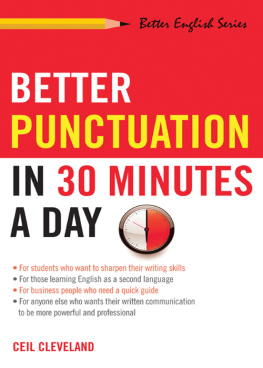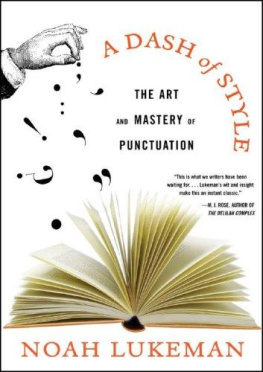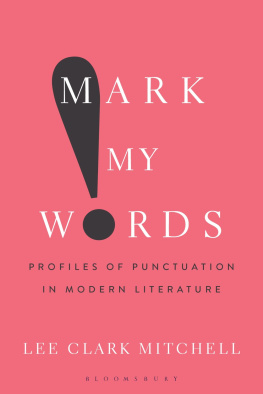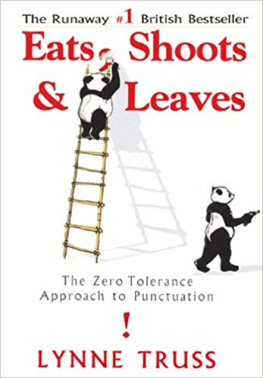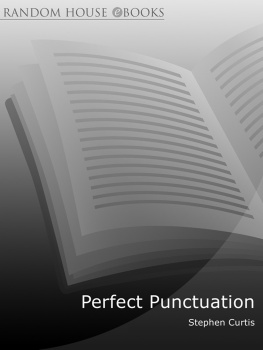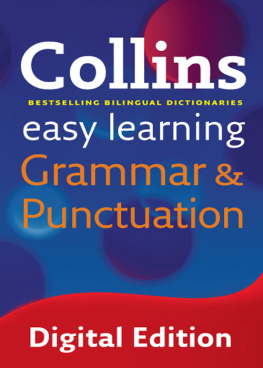
BETTER PUNCTUATION IN 30 MINUTES A DAY
By
Ceil Cleveland

Copyright 2002 by Ceil Cleveland
All rights reserved under the Pan-American and International Copyright Conventions. This book may not be reproduced, in whole or in part, in any form or by any means electronic or mechanical, including photocopying, recording, or by any information storage and retrieval system now known or hereafter invented, without written permission from the publisher, The Career Press.
BETTER PUNCTUATION IN 30 MINUTES A DAY
EDITED BY KATE PRESTON
TYPESET BY EILEEN DOW MUNSON
Cover design by The Visual Group
Printed in the U.S.A.
To order this title, please call toll-free 1-800-CAREER-1 (NJ and Canada: 201-848-0310) to order using VISA or MasterCard, or for further information on books from Career Press.

The Career Press, Inc., 220 West Parkway, Unit 12
Pompton Plains, NJ 07444
www.careerpress.com
Library of Congress Cataloging-in-Publication Data
Cleveland, Ceil.
Better punctuation in 30 minutes a day / Ceil Cleveland.
p. cm.
Includes bibliographical references (p. ) and index.
ISBN 1-56414-626-X (paper)
1. English languagePunctuationProblems, exercises, etc. I. Title: Better punctuation in thirty minutes a day. II. Title.
PE1450 .C56 2002
428.2dc21
2002067551
This book is dedicated to the memory of
Miss Ida Hawkins
of Archer City (Texas) High School,
who was strictbut who saw to it that I
learned this stuff.
It is also dedicated to the memory of
Gertrude McGrath,
my mentor at Columbia University, who was
annoyingbecause in every disagreement
she was always right. I am indebted to these
two strong teachers who insisted that I see
the value in small things that make a big
difference to a writer.

I thank my writing students at New York University, Spring 2002, who suffered through the first draft of this book with metheir strict and annoying teacherand made useful suggestions.
Section I: Leah Abiol, Basit Azhar, Jesse Beatus, Mahmudul Haque, Steven Kardos, Elizabeth Lee, Sang Woo Park, Pritesh Shah, Nathan Silver, Varinder Singh, Catherine Stadler, Jacob Vorreuter, Jennifer Zeng.
Section II: Amy Amargo, Bettina Andrianantoandro, Edwin Azarkian, Jennifer Barry, Deepka Chattaram, Tiffany Childs, Joanna Farah, Allison Fax, Maria Gaskill, Adhish Lal, Adam Lederman, Benjamin Milligan, Jonathan Packin, Bianca Rosa, Yana Rozinov, and Alyson Singer.
Contents
Introduction
Thus all these tiny scratches give us breadth and heft and depth. A world that only has periods is a world without inflections. It is a world without shade. It has a music without sharps and flats. It is a martial music. It has a jackboot rhythma comma can let us hear a voice break, or a heart.
Pico Iyer, Writer
For more than twenty-five years, I have taught college and university students of all levels how to write. The great majority of these students can read with understanding, can think critically, and can analyze what they read. The greatest weakness I have foundand this weakness grows more pronounced each yearis the inability to punctuate sentences correctly. In my experience, students for whom English is a second language (ESL) frequently understand grammar and punctuation better than students who have listened to and spoken English since their infancy. Why is this? Because ESL students had to learn syntax and how the language works in order to construct sensible sentences and clearly express themselves. They could not depend on their ears or intuition to help them.
Who Cares?
These little commas, semicolons, periods, dashes, and apostrophes are small markings, certainly. However, they are essential to clear writing. We do not care about them because some self-important English professor in the sky has proclaimed them important or wants to torment frazzled students. We care about punctuation because without it people cannot communicate clearly. Clear, precise communication is the endgame of all writing.
Without the guides of proper punctuation, rightful heirs have failed to claim their inheritances because a lawyer put a comma in the wrong place in a will.
Do you want to leave equal parts of your estate to Mary, Sally, and Tim? Or to Mary, Sally and Tim? Does this mean Sally and Tim share a portion, and Mary has a portion to herself?
Legal experts have disagreed on this. Fortunes have risen and fallen on the placement of a comma.
Without proper punctuation, a cook might spoil the soup.
Compare these directions:
Add milk slowly, stirring constantly.
Add milk, slowly stirring constantly.
To assure smooth soup, choose the first.
Heres an old example that is worth repeating:
A professor once wrote the following words on the chalkboard and asked the class to punctuate it:
Woman without her man is nothing.
The men punctuated it this way:
Woman, without her man, is nothing.
The women punctuated it this way:
Woman! Without her, man is nothing.
Making Your Sentences Rock
Punctuation is the notation in the sheet music of our words, telling us where to rest, or when to raise our voices; it acknowledges that the meaning of our discourse, as of any symphonic composition, lies not in the units but in the pauses, the pacing, and the phrasing.
Pico Iyer
Students often think that punctuation has to do with the natural rhythm of a sentence. Sometimes it does. A comma sometimes indicates where your voice falls or pauses as you read. But thats thinking about the structure of the language backward: we dont all define natural in the same way, let alone rhythm. A reader doesnt know where the voice should lift, fall, pause, or accelerate until a writer gives him some clues. A writer who gives the wrong clues, or no clues at all, leaves the readerwellclueless. The reader doesnt know when to breathe or let the voice fall, rise, or run on. After all, even a drummer in an orchestra needs a score to indicate where the beats should go.
Signal Lights
Punctuationhas a point: to keep law and order.
Pico Iyer
A profession I admire, especially when I am driving on a busy street or an expressway, is that of the highway engineer. The engineer has to know exactly where to place the signsstop, go, wait, yield, mergeor cars will collide. Its a precise business. The same can be said of the writing business. In a short sentence (think of a country road), a period is a red light, a semicolon is an amber light, a comma is a green light. In a long, complicated sentence (think of a busy highway), these three basic punctuation signs tell you when to merge. A colon can tell you to watch for whats coming next: cars, deer, or small children. If you know how to drive and read street signs, you can transfer that knowledge to your writing.
Your Tool Kit
Punctuationis a civic prop, a pillar that holds society upright.
Pico Iyer
Another way to think of punctuation marks is this: They are, to the structure of the English language, what nails, screws, and bolts are to the structure of a house. Use a nail where a screw or bolt should be placed, and the structure of the house is weakened. Make too many of these mistakes, and the house will fall down. The reason for learning our languages structure is to make our sentences hold up, to make our words communicate exactly what we want them to.
Next page
